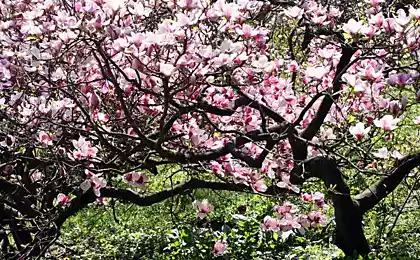844
Magnolia - chastity tree on your site
Magnolia - tree with incredibly beautiful flowers that will decorate your garden, make it bright and expressive, filling alluring vanilla and lemon flavor. And do not be afraid of its possible moodiness: I will try to dispel all doubts and will share the intricacies of growing and caring for magnolia.

The symbol of the virgin purity in China, magnolia and held in high esteem here. Her extraordinary beauty and intoxicating fragrance has long admired.
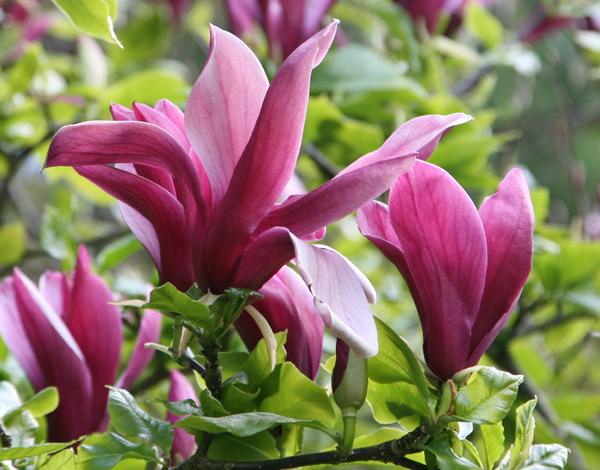
In the middle zone, it begins to bloom in April, when most of the trees are not even covered with leaves. Apparently, therefore, huge flowers cause surprise and delight. While magnolia valued not only for their beauty. Its leaves, flowers, fruits, and even bark contains essential oils - a unique antiseptic agent for hypertension, rheumatism and diseases of the digestive system.
Magnolia (after the famous botanist P. Magnolia) - one of the brightest representatives of the family Magnoliaceae, which comprises more than 70 species. Its magnificent trees with broad pyramidal or spherical crown can reach 5-8 and even 20 m in height. Depending on the variety, flowers can be white, pink, purple, red and even purple. However, of the 120 varieties grown in the middle lane is possible only a few (the rest is really picky and just will not survive our harsh winters): Kobus magnolia (Magnolia kobus), Magnolia stellata (Magnolia stellata) and some of their hybrids. Later, we will examine them in detail, but for now let's talk about the nuances of growing this wonderful plant.
Magnolia Landing
Before planting magnolia, you need to choose the right seedling: it must be closed root system. About that, what else to look for when choosing seedlings, you can read in the articles:
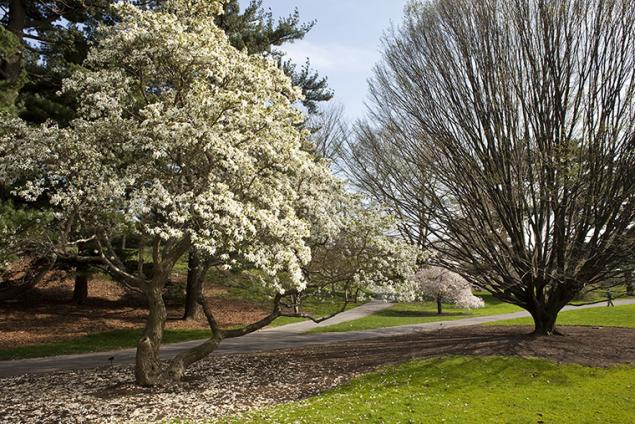
Landing site is determined in advance, given that magnolia:
prefers protected from winds and drafts sections;
It did not suffer much limed soil: they do not develop roots and almost could die. If the soil in your yard it is this, mix it with sour peat, it will lower the pH;
It grows poorly on heavy, waterlogged and sandy soils.
The best place to land is sunny, in the southern regions - slightly shading portion with a light fertile soil.
Regarding the timing of planting, most gardeners agree that to plant a magnolia better in the autumn, when the young plants have stopped in growth, like "falling into hibernation." Autumn planting must be done in mid to late October, when the severe frost yet, and the unbearable heat - no longer exists.
Regarding the spring planting of disagreement. Some gardeners believe that the young seedlings magnolia, like most trees can be planted in the spring - in April. The latter assert that even a small return frosts can cause already having got to the growth of trees irreparable harm, after which rehabilitation will be a long and likely to be ineffective. Listen to this controversial opinions or not - it's up to you. But consider whether the risk is justified: after all, the right sapling planted in the fall to 100% take root.
Choosing a place, we begin to prepare the planting hole. Note that the size of the hole should be three times the volume of the root system of seedlings. Taking the necessary amount of soil, mix it with rotted compost. If the soil is too thick, add a little sand. After preparing the soil mixture, set the seedling into the planting hole, in any case, not buried root neck, and covered it with a mixture, so that the surrounding trees formed a small hole. Then lightly thicken the ground in the well and a good pour. Once the water is absorbed into the soil, tree trunks circle mulching with peat / sand or bark of conifers camouflage.
Reproduction
magnolia Magnolia is easily propagated vegetatively: vaccinations, layering and cuttings, but you may want to try to grow a plant from seed. Let's look at each option:
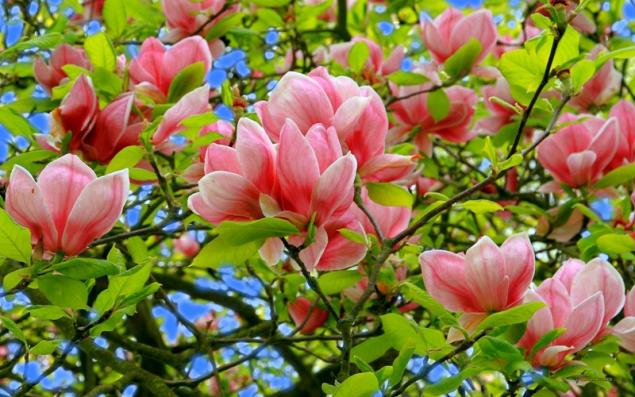
How to grow a magnolia seed?
Sow the seeds of magnolia better immediately after collecting berries in the fall, because to keep them until the spring is difficult. Since the seeds are covered with very dense, oily skin, they first need to scarify, ie mechanically destroy the shell (or nadpilit Chipped). After scarification magnolia seeds are washed in a mild soap solution to remove the oily layer and rinsed in clean water. Sow the seeds to a depth of 3 cm in the boxes with the universal substrate, they cleaned the cellar until spring. In early March, the seeds move boxes on the window sill, constantly monitoring to the substrate is not dried out, and wait for germination.
Rusty young seedlings magnolia for the first time will not be very fast: in the first year of life they reach somewhere 20-50 cm only after a year you can dive and seedlings planted on beds with a light peat soil..
Propagation by cuttings and layering magnolia (vegetative)
Vegetatively propagated magnolia better in the first years of life, so it will grow very quickly.
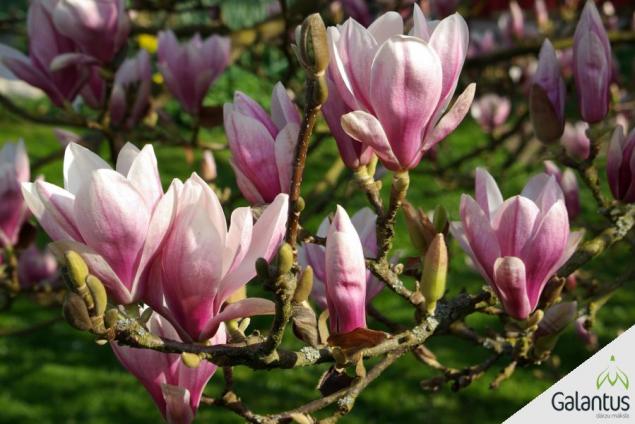
Magnolia is easily propagated by layering. To this end, the spring is enough to bend down, sprinkle the soil and pinned part of the lower branches, and after 1-2 years formed strong roots in this branch. After the formation of the roots of strains neatly separated from the mother plant and "resettled" in the nursery for rearing.
There is nothing complicated in the reproduction of magnolia semilignified cuttings, but the success of the experiment is guaranteed only if you have a greenhouse. Well, or its smaller version - a mini-greenhouse with bottom heating of the soil. Only mini-greenhouse, you can adjust the temperature and humidity, which is very important when breeding magnolia manner.
The best time for propagation by cuttings of magnolia - the end of June, at this time it is actively growing. Cuttings are cut from young plants, on top of each leave 2-3 leaves, and the lower part of the process by any stimulator rooting. They were then planted in a sandy substrate capacitance (or half clean sand mixed with perlite / peat), which must always remain moderately wet, covered with a lid and provide temperature control in the range 19-22 ° C. The lower / higher temperatures and the drying of the substrate will lead to the death of cuttings. Handles virtually all magnolias are beginning to take root after about 7-8 weeks, except in cuttings magnolia grandiflora, which on rooting takes about 4 months. In the open field grown seedlings are planted rooted only a year later.
Care magnolia
Magnolia is rightly considered not particularly demanding in plant care. Nevertheless, some attention paid to it will have.
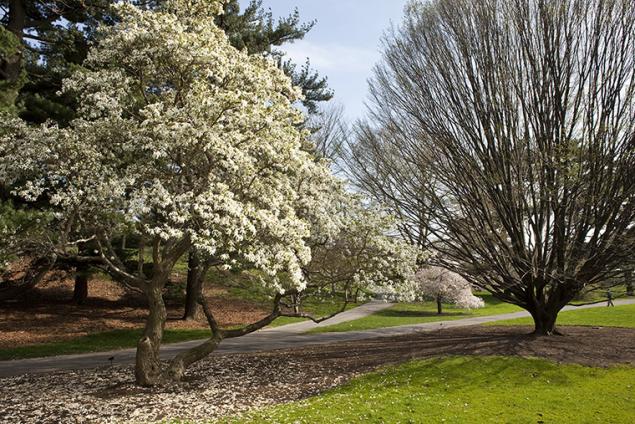
Watering
Magnolia is very demanding on the soil moisture, especially during the first three years of life. Therefore, it must be watered frequently and abundantly, and in very hot weather - to avoid drying of the soil. Save the moisture helps not only the glaze, but mulching: it perfectly warms the roots (which is especially important in winter) and serves as a source of nutrients, while improving soil structure and significantly reducing its desiccation.
Shelter
Despite the fact that the magnolia, which are cultivated in our country (Kobus, stellate and their hybrids) hardy, shelter she was not hurt. After all, even a small return freezing can cause damage to new shoots and flower buds. To avoid frost-crack, simply wrap the trunks in burlap 2 layer. But remember, it should be done very carefully, from the magnolia branches are very fragile! The shelter needs and the tree trunks of the tree, it should only cover the late fall, after the soil freezes slightly: only in this way in the shelter will not be able to equip your home mouse.
Pruning
If freezing of small could not be avoided, and the tops of the branches still podmerzli, you must carry out pruning of branches to healthy wood, and place slices gloss over garden pitch. In addition, you need to cut all the damaged, dry and intersecting branches inside the crown. But in the formative pruning magnolias do not need.
Dressing
magnolia While magnolia very responsive to fertilizer, in the first 2 years of life is not recommended to feed her. But the three-year seedlings magnolia already need additional receipt of nutrients, so fertilizer is very handy. Make fertilizer must be from early spring until late August. Nitrogen, which increases the tendency of plants to freezing, apply only until mid-July.
The fertilizer can be prepared independently, using 20 g of ammonium nitrate, 15 g of urea and 1 kg of mullein, diluted in 10 liters of water. Consumption of fertilizer under the tree 1 is 40 liters.
You can also use a solution of complete fertilizer "Kemira-Universal", for the preparation of a bucket of water in which I dissolve 1 tablespoon drug. There are also a number of fertilizer designed specifically for feeding magnolia example, AGRECOL «For magnolia»
. And remember: everything is good in moderation. This is true of fertilizer, the excess of which can only harm the plant. If an overdose has occurred yet, which can be determined by dry up at the end of July, the old leaves, try to fix it with the help of weekly abundant watering.
Pests
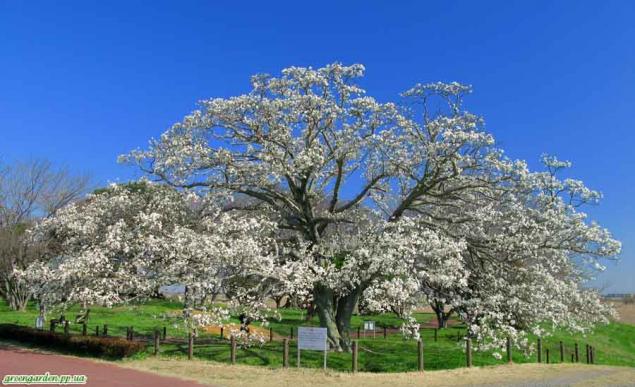
Voles and moles can cause irreparable harm to the magnolia. The first gnaw the root neck of the plant and its roots, and the latter undermine the roots. And if you find that the trunk is damaged, treat the wound with a solution of 1% fundazol.
Strong harm can and spider mite, which is activated during a drought. Pest feeds on the underside of leaves, completely sucking the juices from them, which leads to their dying off.
Types and varieties of magnolia
Magnolia can be deciduous and evergreen. The first responds to changes in temperature only changes in the timing of flowering and the second sustain large frost is not able to do so in the middle lane it is cultivated only in greenhouses to a certain temperature.
Among the 120 varieties of magnolias there are not a lot of winter-hardy and relatively hardy varieties. So, for winter-hardy varieties that can be grown easily in the middle band are: Kobus magnolia (Magnolia kobus), Magnolia stellata (Magnolia stellata) and hybrid and Kobus Magnolia stellata - Magnolia Lebnera
. For relatively winter-hardy, who in extreme cold podmerznet only part of the flower buds are garden forms of Ash and Sulanzha.
Kobus Magnolia (Magnolia kobus)
Kobus magnolia tree varieties reach 8-12 m in height and are characterized by an unusual crown, which in the first years of life has a pyramidal shape with age changing to spherical.
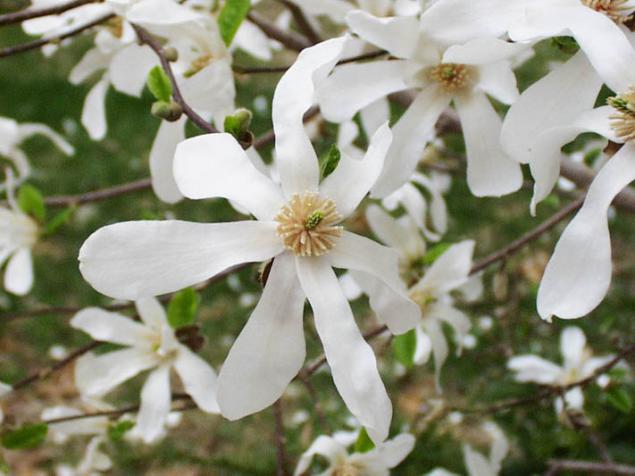
Magnolia Kobus rightly considered the most hardy and undemanding to care for variety, but it is cultivated in our extremely rare. And here's the thing: shoot from the seed to the period until the tree will appreciate its color, it will take about 30 years. Although who can wait will be rewarded handsomely: in addition, that the magnolia varieties Kobus undemanding of care, in April-May, it will give you an incredibly beautiful white flowers with a purple base. Dark green leaves with the arrival of autumn are painted in yellow-brown color and fall only to the mid-autumn.
Magnolia stellata (Magnolia stellata)
Most wood, rarely - shrub up to 5-6 m, with a spherical or oval crown, Magnolia stellata in width up to 4, 5 or even 5 m during flowering Magnolia stellata exudes a very pleasant, enveloping and persistent aroma
..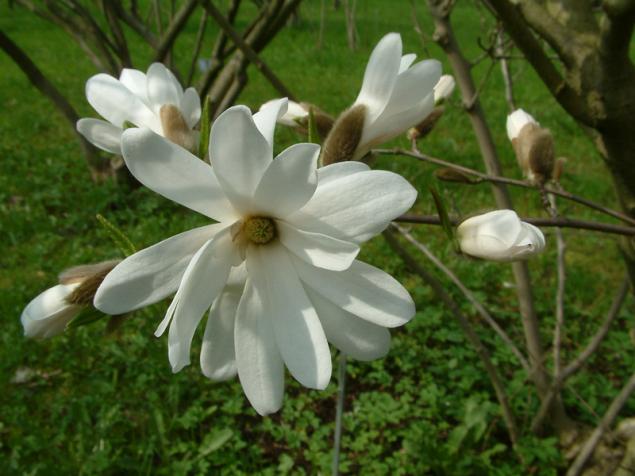
And Magnolia stellata blooms earlier than the rest - in March-April, and then the entire tree is covered with dark green leaves up to 7-10 cm, which in autumn are bronze-yellow.
Lebnera Magnolia (Magnolia x loebneri)
Magnolia Lebnera - a hybrid Kobus magnolia and star who took the best from their parents: the endurance and beauty of the crown of the first and second intoxicating aroma.
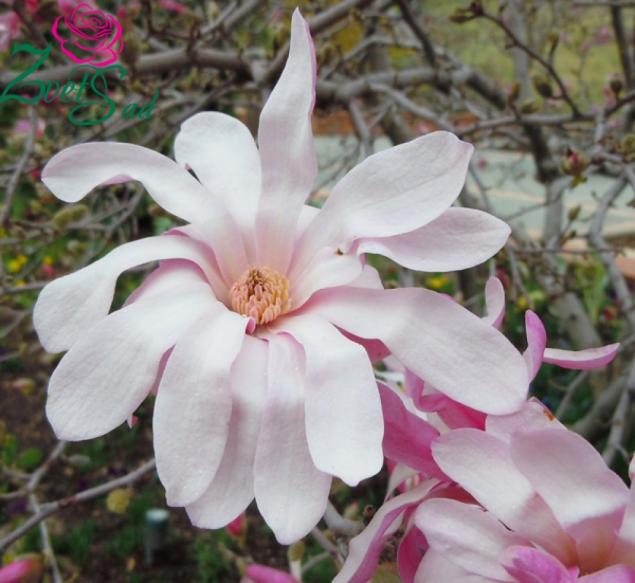
Magnolia Lebnera -. Tree with rounded crown, reaching a height of 9 m Fragrant flowers Magnolia x loebneri, white with a slight pinkish tinge, bloom in April, and the green leaves all summer, just like Magnolia stellata, by fall colored in yellow bronze color.
Magnolia × Soulangeana (Magnolia x soulangeana)
The most common in our markets Magnolia × Soulangeana.

It is a 5-10-meter tree, in April and May are covered with a continuous carpet of fragrant pink-purple flowers with a diameter of 10-25 cm, which resemble tulips. Dark green leaves in autumn Magnolia × Soulangeana become a dirty yellow.
Ashe magnolia (Magnolia macrophylla ssp.ashei)
One of the most beautiful and hardy deciduous magnolia - Magnolia Ash - will give you a rapid flowering already in the 2-5 year life.
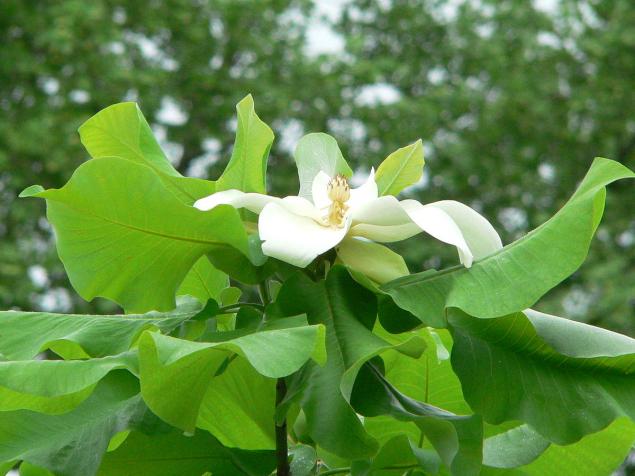
Ashe magnolia tree reaches a height of 5 and sometimes 7 meters and almost never suffer from recurrent frosts. And the thing is that it blooms much later than the other species - in the middle, and sometimes towards the end of May. In addition, the bloom lasts much longer than the early-flowering. Huge white with a cream shade flowers reach a diameter of 25, and sometimes 30 cm and leaves amazing tropical species reach a length of 50-70 cm.
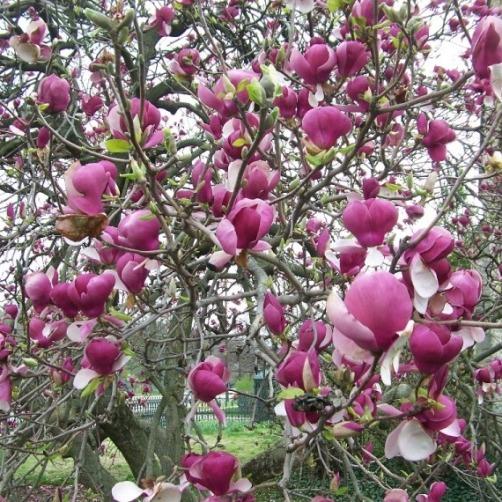
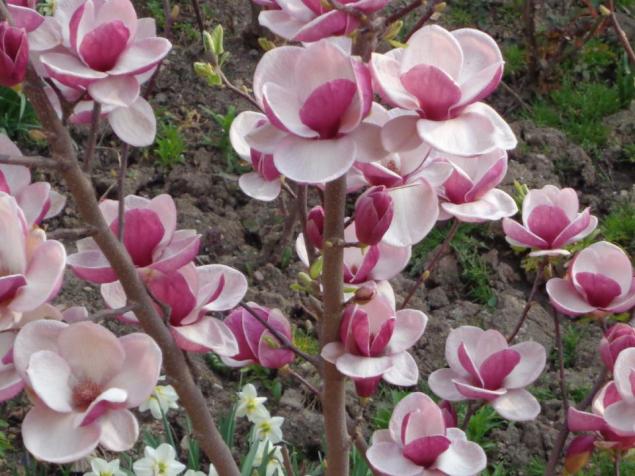

The symbol of the virgin purity in China, magnolia and held in high esteem here. Her extraordinary beauty and intoxicating fragrance has long admired.

In the middle zone, it begins to bloom in April, when most of the trees are not even covered with leaves. Apparently, therefore, huge flowers cause surprise and delight. While magnolia valued not only for their beauty. Its leaves, flowers, fruits, and even bark contains essential oils - a unique antiseptic agent for hypertension, rheumatism and diseases of the digestive system.
Magnolia (after the famous botanist P. Magnolia) - one of the brightest representatives of the family Magnoliaceae, which comprises more than 70 species. Its magnificent trees with broad pyramidal or spherical crown can reach 5-8 and even 20 m in height. Depending on the variety, flowers can be white, pink, purple, red and even purple. However, of the 120 varieties grown in the middle lane is possible only a few (the rest is really picky and just will not survive our harsh winters): Kobus magnolia (Magnolia kobus), Magnolia stellata (Magnolia stellata) and some of their hybrids. Later, we will examine them in detail, but for now let's talk about the nuances of growing this wonderful plant.
Magnolia Landing
Before planting magnolia, you need to choose the right seedling: it must be closed root system. About that, what else to look for when choosing seedlings, you can read in the articles:

Landing site is determined in advance, given that magnolia:
prefers protected from winds and drafts sections;
It did not suffer much limed soil: they do not develop roots and almost could die. If the soil in your yard it is this, mix it with sour peat, it will lower the pH;
It grows poorly on heavy, waterlogged and sandy soils.
The best place to land is sunny, in the southern regions - slightly shading portion with a light fertile soil.
Regarding the timing of planting, most gardeners agree that to plant a magnolia better in the autumn, when the young plants have stopped in growth, like "falling into hibernation." Autumn planting must be done in mid to late October, when the severe frost yet, and the unbearable heat - no longer exists.
Regarding the spring planting of disagreement. Some gardeners believe that the young seedlings magnolia, like most trees can be planted in the spring - in April. The latter assert that even a small return frosts can cause already having got to the growth of trees irreparable harm, after which rehabilitation will be a long and likely to be ineffective. Listen to this controversial opinions or not - it's up to you. But consider whether the risk is justified: after all, the right sapling planted in the fall to 100% take root.
Choosing a place, we begin to prepare the planting hole. Note that the size of the hole should be three times the volume of the root system of seedlings. Taking the necessary amount of soil, mix it with rotted compost. If the soil is too thick, add a little sand. After preparing the soil mixture, set the seedling into the planting hole, in any case, not buried root neck, and covered it with a mixture, so that the surrounding trees formed a small hole. Then lightly thicken the ground in the well and a good pour. Once the water is absorbed into the soil, tree trunks circle mulching with peat / sand or bark of conifers camouflage.
Reproduction
magnolia Magnolia is easily propagated vegetatively: vaccinations, layering and cuttings, but you may want to try to grow a plant from seed. Let's look at each option:

How to grow a magnolia seed?
Sow the seeds of magnolia better immediately after collecting berries in the fall, because to keep them until the spring is difficult. Since the seeds are covered with very dense, oily skin, they first need to scarify, ie mechanically destroy the shell (or nadpilit Chipped). After scarification magnolia seeds are washed in a mild soap solution to remove the oily layer and rinsed in clean water. Sow the seeds to a depth of 3 cm in the boxes with the universal substrate, they cleaned the cellar until spring. In early March, the seeds move boxes on the window sill, constantly monitoring to the substrate is not dried out, and wait for germination.
Rusty young seedlings magnolia for the first time will not be very fast: in the first year of life they reach somewhere 20-50 cm only after a year you can dive and seedlings planted on beds with a light peat soil..
Propagation by cuttings and layering magnolia (vegetative)
Vegetatively propagated magnolia better in the first years of life, so it will grow very quickly.

Magnolia is easily propagated by layering. To this end, the spring is enough to bend down, sprinkle the soil and pinned part of the lower branches, and after 1-2 years formed strong roots in this branch. After the formation of the roots of strains neatly separated from the mother plant and "resettled" in the nursery for rearing.
There is nothing complicated in the reproduction of magnolia semilignified cuttings, but the success of the experiment is guaranteed only if you have a greenhouse. Well, or its smaller version - a mini-greenhouse with bottom heating of the soil. Only mini-greenhouse, you can adjust the temperature and humidity, which is very important when breeding magnolia manner.
The best time for propagation by cuttings of magnolia - the end of June, at this time it is actively growing. Cuttings are cut from young plants, on top of each leave 2-3 leaves, and the lower part of the process by any stimulator rooting. They were then planted in a sandy substrate capacitance (or half clean sand mixed with perlite / peat), which must always remain moderately wet, covered with a lid and provide temperature control in the range 19-22 ° C. The lower / higher temperatures and the drying of the substrate will lead to the death of cuttings. Handles virtually all magnolias are beginning to take root after about 7-8 weeks, except in cuttings magnolia grandiflora, which on rooting takes about 4 months. In the open field grown seedlings are planted rooted only a year later.
Care magnolia
Magnolia is rightly considered not particularly demanding in plant care. Nevertheless, some attention paid to it will have.

Watering
Magnolia is very demanding on the soil moisture, especially during the first three years of life. Therefore, it must be watered frequently and abundantly, and in very hot weather - to avoid drying of the soil. Save the moisture helps not only the glaze, but mulching: it perfectly warms the roots (which is especially important in winter) and serves as a source of nutrients, while improving soil structure and significantly reducing its desiccation.
Shelter
Despite the fact that the magnolia, which are cultivated in our country (Kobus, stellate and their hybrids) hardy, shelter she was not hurt. After all, even a small return freezing can cause damage to new shoots and flower buds. To avoid frost-crack, simply wrap the trunks in burlap 2 layer. But remember, it should be done very carefully, from the magnolia branches are very fragile! The shelter needs and the tree trunks of the tree, it should only cover the late fall, after the soil freezes slightly: only in this way in the shelter will not be able to equip your home mouse.
Pruning
If freezing of small could not be avoided, and the tops of the branches still podmerzli, you must carry out pruning of branches to healthy wood, and place slices gloss over garden pitch. In addition, you need to cut all the damaged, dry and intersecting branches inside the crown. But in the formative pruning magnolias do not need.
Dressing
magnolia While magnolia very responsive to fertilizer, in the first 2 years of life is not recommended to feed her. But the three-year seedlings magnolia already need additional receipt of nutrients, so fertilizer is very handy. Make fertilizer must be from early spring until late August. Nitrogen, which increases the tendency of plants to freezing, apply only until mid-July.
The fertilizer can be prepared independently, using 20 g of ammonium nitrate, 15 g of urea and 1 kg of mullein, diluted in 10 liters of water. Consumption of fertilizer under the tree 1 is 40 liters.
You can also use a solution of complete fertilizer "Kemira-Universal", for the preparation of a bucket of water in which I dissolve 1 tablespoon drug. There are also a number of fertilizer designed specifically for feeding magnolia example, AGRECOL «For magnolia»
. And remember: everything is good in moderation. This is true of fertilizer, the excess of which can only harm the plant. If an overdose has occurred yet, which can be determined by dry up at the end of July, the old leaves, try to fix it with the help of weekly abundant watering.
Pests

Voles and moles can cause irreparable harm to the magnolia. The first gnaw the root neck of the plant and its roots, and the latter undermine the roots. And if you find that the trunk is damaged, treat the wound with a solution of 1% fundazol.
Strong harm can and spider mite, which is activated during a drought. Pest feeds on the underside of leaves, completely sucking the juices from them, which leads to their dying off.
Types and varieties of magnolia
Magnolia can be deciduous and evergreen. The first responds to changes in temperature only changes in the timing of flowering and the second sustain large frost is not able to do so in the middle lane it is cultivated only in greenhouses to a certain temperature.
Among the 120 varieties of magnolias there are not a lot of winter-hardy and relatively hardy varieties. So, for winter-hardy varieties that can be grown easily in the middle band are: Kobus magnolia (Magnolia kobus), Magnolia stellata (Magnolia stellata) and hybrid and Kobus Magnolia stellata - Magnolia Lebnera
. For relatively winter-hardy, who in extreme cold podmerznet only part of the flower buds are garden forms of Ash and Sulanzha.
Kobus Magnolia (Magnolia kobus)
Kobus magnolia tree varieties reach 8-12 m in height and are characterized by an unusual crown, which in the first years of life has a pyramidal shape with age changing to spherical.

Magnolia Kobus rightly considered the most hardy and undemanding to care for variety, but it is cultivated in our extremely rare. And here's the thing: shoot from the seed to the period until the tree will appreciate its color, it will take about 30 years. Although who can wait will be rewarded handsomely: in addition, that the magnolia varieties Kobus undemanding of care, in April-May, it will give you an incredibly beautiful white flowers with a purple base. Dark green leaves with the arrival of autumn are painted in yellow-brown color and fall only to the mid-autumn.
Magnolia stellata (Magnolia stellata)
Most wood, rarely - shrub up to 5-6 m, with a spherical or oval crown, Magnolia stellata in width up to 4, 5 or even 5 m during flowering Magnolia stellata exudes a very pleasant, enveloping and persistent aroma
..

And Magnolia stellata blooms earlier than the rest - in March-April, and then the entire tree is covered with dark green leaves up to 7-10 cm, which in autumn are bronze-yellow.
Lebnera Magnolia (Magnolia x loebneri)
Magnolia Lebnera - a hybrid Kobus magnolia and star who took the best from their parents: the endurance and beauty of the crown of the first and second intoxicating aroma.

Magnolia Lebnera -. Tree with rounded crown, reaching a height of 9 m Fragrant flowers Magnolia x loebneri, white with a slight pinkish tinge, bloom in April, and the green leaves all summer, just like Magnolia stellata, by fall colored in yellow bronze color.
Magnolia × Soulangeana (Magnolia x soulangeana)
The most common in our markets Magnolia × Soulangeana.

It is a 5-10-meter tree, in April and May are covered with a continuous carpet of fragrant pink-purple flowers with a diameter of 10-25 cm, which resemble tulips. Dark green leaves in autumn Magnolia × Soulangeana become a dirty yellow.
Ashe magnolia (Magnolia macrophylla ssp.ashei)
One of the most beautiful and hardy deciduous magnolia - Magnolia Ash - will give you a rapid flowering already in the 2-5 year life.

Ashe magnolia tree reaches a height of 5 and sometimes 7 meters and almost never suffer from recurrent frosts. And the thing is that it blooms much later than the other species - in the middle, and sometimes towards the end of May. In addition, the bloom lasts much longer than the early-flowering. Huge white with a cream shade flowers reach a diameter of 25, and sometimes 30 cm and leaves amazing tropical species reach a length of 50-70 cm.


